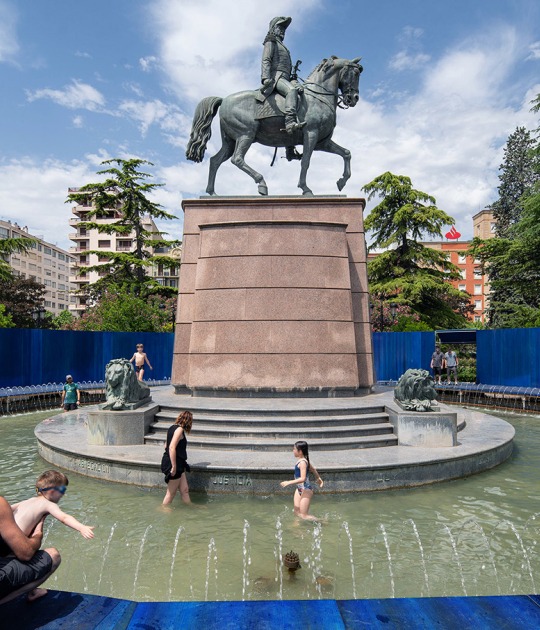Le Corbusier and Jean Genet in the Raval.
Le Corbusier and Jean Genet inspire the first part, that contains as centerpiece the diorama of the Pla Macià (1934). The project sought an urban renewal of the center of Barcelona. In contrast, Jean Genet, who wandered through the "Barrio Chino" shortly after Le Corbusier did, coincided with the most abject aspects of the street. His novel "The Thief's Journal" (1949) is related to the elapsed time in this city. So both the modernity associated to the rationalism, engaged in physical and moral sanitation, and that other that explores formlessness and marginality, coincided in time and space.
Gordon Matta-Clark. Portfolio Office Baroque.
The second part focuses on the project Office Baroque (1977), one of the last building cuts conducted by Gordon Matta-Clark. The portfolio Office Baroque comprises 44 black and white photographs documenting a large number of actions by Matta-Clark throughout the seventies. Thanks to a deposit of the art collector Harold Berg and to the acquisition of a series of drawings about the project Sky Hooks (1978), the MACBA becomes a referent institution to know in depth the contributions of this artist. This chapter is prolonged by one of the most famous «solid light sculptures» by Anthony McCall, Line Describing a Cone (1973), that had a decisive influence on the form taken by the last building cuts.
Roberto Rossellini. Filming Beaubourg.
Finally, a third part closes this route with the recovery of the film commissioned by the French government to Roberto Rossellini to celebrate the opening of the Centre Pompidou. The film has unpublished documents showing Rossellini during the filmmaking process, and images of his participation in the Festival de Cannes, shortly before his death. This itinerary takes us from the Barcelona of the early thirties until Paris of 1977, through episodes of demolition of buildings and degraded areas of the city emerging as the leitmotiv of urban crises.
Date.- From June 7th to 21 October 21st 2012.
Venue.- Museu d'Art Contemporani de Barcelona (MACBA). Plaça dels Àngels, 1. 08001 Barcelona.
Schedule.- Workdays from 11:00 to 19:30 (from June 25th to September 24th, from 11:00 to 20:00). Satuday, from 10:00 to 20:00. Sunday and holidays, from 10:00 to 15:00. Closed on Tuesday. Open on Monday.
Daily guided tours (included in entrance fee).







![Gordon Matta-Clark Office Baroque [Documentation of "Office Baroque" 1977 in Anvers, Belgium] Col·lecció MACBA. Fundació MACBA. Col·lecció LATA © Estate of Gordon Matta Clark, VEGAP, Barcelona, 2012. Photography: Vanessa Miralles. Gordon Matta-Clark Office Baroque [Documentation of "Office Baroque" 1977 in Anvers, Belgium] Col·lecció MACBA. Fundació MACBA. Col·lecció LATA © Estate of Gordon Matta Clark, VEGAP, Barcelona, 2012. Photography: Vanessa Miralles.](/sites/default/files/styles/mopis_news_carousel_item_desktop/public/ml_mattaclark_05_1024_0.jpg?itok=7Mi9Rbky)
![Gordon Matta-Clark Office Baroque [Documentation of "Office Baroque" 1977 in Anvers, Belgium] Col·lecció MACBA. Fundació MACBA. Col·lecció LATA © Estate of Gordon Matta Clark, VEGAP, Barcelona, 2012. Photography: Vanessa Miralles. Gordon Matta-Clark Office Baroque [Documentation of "Office Baroque" 1977 in Anvers, Belgium] Col·lecció MACBA. Fundació MACBA. Col·lecció LATA © Estate of Gordon Matta Clark, VEGAP, Barcelona, 2012. Photography: Vanessa Miralles.](/sites/default/files/styles/mopis_news_carousel_item_desktop/public/ml_mattaclark_01_1024_0.jpg?itok=dGzsg26c)















![Matta-Clark, Gordon Office Baroque, 4th Floor [Documentació de l'acció "Office Baroque" realitzada el 1977 a Anvers, Bèlgica] 1977 Fotografia a les sals de plata 25,3 x 20,3 cm Col·lecció MACBA. Fundació Museu d'Art Contemporani de Barcelona. Dipòsit Col·lecció LATA Matta-Clark, Gordon Office Baroque, 4th Floor [Documentació de l'acció "Office Baroque" realitzada el 1977 a Anvers, Bèlgica] 1977 Fotografia a les sals de plata 25,3 x 20,3 cm Col·lecció MACBA. Fundació Museu d'Art Contemporani de Barcelona. Dipòsit Col·lecció LATA](/sites/default/files/styles/mopis_home_news_category_slider_desktop/public/lead-images/ml4147_mg_8986.jpg?h=8b2a012f&itok=v0X8-j5Z)







